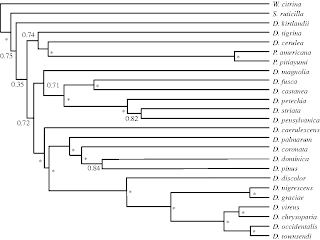Ever since I started birding, I have especially delighted in the birds of the family Parulidae, the North American wood warblers. So it should not be surprising that this blog has one of its genera as its domain namesake, or that I write about them frequently, or that I use one species as my mascot. It is with good reason: these jewels of North American woodlands provide a prime example of avian diversity. The genus Dendroica, in particular, includes (at least) twenty-seven species with a multitude of plumages and specialized adaptations.
This remarkable diversity evolved in a short burst soon after the genus Dendroica split from its ancestral lineage. Most species in the genus emerged within its first million years, and then the rate of diversification slowed down considerably. One explanation for this is that rapid diversification occurs when new ecological opportunities open. As the available niches fill, increased competition from existing species makes it harder for new species to appear.
The authors of the linked paper devised a mathematical model to test that explanation against other possible causes for a decline in speciation rates. An extensive DNA analysis for all continental members of the genus established both the order in which new species appeared and how quickly they did so. (See their new phylogenetic tree below.) The timeline established via DNA analysis supported the idea that the diversification rate for Dendroica warblers spiked quickly and then dropped due to niches being filled. Figure 1: Maximum clade credibility (MCC) tree from Bayesian analysis of all continental North American Dendroica wood warbler species. Nodes marked with asterisks are supported by posterior probabilities of more than 0.95. Tree is based on more than 9kb of mtDNA and nuclear intron sequence. Branch lengths are proportional to absolute time. (Source: Proceedings of the Royal Society B, DOI: 10.1098/rspb.2008.0630)
Figure 1: Maximum clade credibility (MCC) tree from Bayesian analysis of all continental North American Dendroica wood warbler species. Nodes marked with asterisks are supported by posterior probabilities of more than 0.95. Tree is based on more than 9kb of mtDNA and nuclear intron sequence. Branch lengths are proportional to absolute time. (Source: Proceedings of the Royal Society B, DOI: 10.1098/rspb.2008.0630)
This paper builds on an earlier finding that the Dendroica lineage arose in the late Miocene or early Pliocene, roughly five million years ago. That transition was accompanied by climate change. As the North American climate became hotter and drier, extensive woodlands fragmented into smaller patches. This change in the landscape may have given wood warblers their opportunity to diversify. Later in the Pliocene, the climate and landscape became more like the present, and those changes may have sparked the secondary burst of speciation.
As an aside, it is interesting that the oldest species in Dendroica – Kirtland's warbler (D. kirtlandii) – is also one of the most endangered species in the genus. (It is probably just a coincidence, since the genus's other endangered species – golden-cheeked warbler (D. chrysoparia) – is among the newest.) Modern humans, by contrast, appeared relatively recently and first entered North America even more recently. Millions of years before humans ever set foot on this continent, these tiny birds were winging their way between their summer and winter territories. That is an amazing thought to keep in mind when fall migration comes again.
Source: Daniel L. Rabosky and Irby J. Lovette, "Density-dependent diversification in North American wood warblers," Proceedings of the Royal Society B, published online (July 8, 2008). doi: 10.1098/rspb.2008.0630



